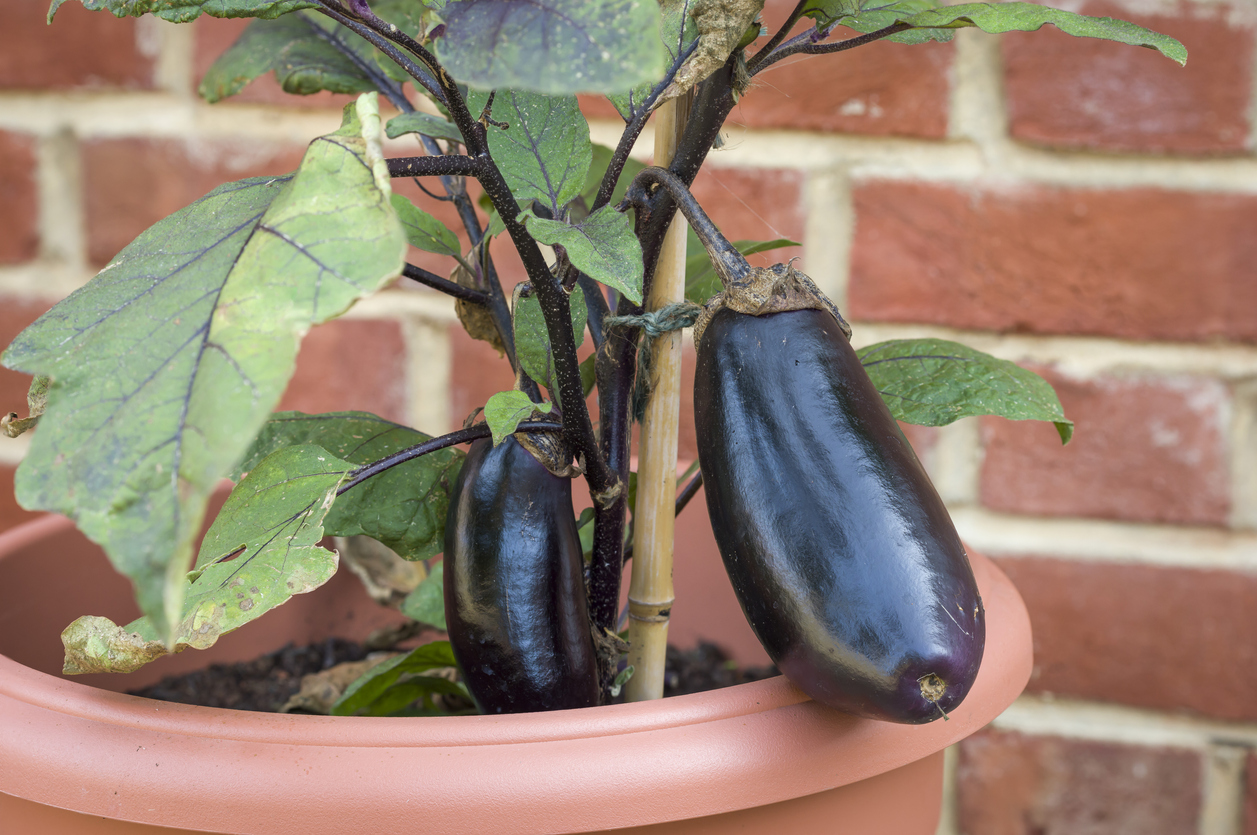Nightshades are such beautiful plants, and eggplant is no exception. Eggplant fruit range in average size from over a foot long, to just a few inches. The larger varietals are thick and hearty, while the smaller types, like Fairy Tale Eggplant, are thin-skinned and delicate (but still great on the grill!) Eggplant certainly has its preferences for growing environments, but if you’ve never tried to grow eggplant in containers before, you might be surprised to learn that they will be quite happy there!
See, eggplants like warm, humid conditions. They want to be damp, but not wet, and they hate to be dry. Containers provide the perfect environment for all of their needs, so long as you’re watering accordingly. And smaller types of eggplant won’t take up much space at all; you can even grow them indoors and hand-pollinate. They do like to climb and need a lot of support, so keep that in mind when deciding on containers. Ones with a trellis attached or nearby would be ideal.

If you want to grow eggplant in containers, here are a few things to keep in mind:
1. Start your seeds indoors. While tropical climates can lend to successful direct seed-sowing, you’ll always have more control indoors and more likely a better outcome. Since you’ll be growing in a container, you can start your seeds right in the container you plan to grow in, but eggplants have no trouble being transplanted either, so if you use seed-starter trays, that’s fine too.
2. Choose a sunny spot in the yard or on the patio. Eggplants need at least six hours of sunlight each day to flourish. They can tolerate some shade, but the more sun, the bigger and better your eggplants will become. And if you’re growing mini eggplants, you still want lots of sun because they’ll taste better too! Putting your container on wheels is one way to help your eggplants get the sunlight they need. Just move them when you need to.
3. Focus your energy on water. All plants have their special needs, and for eggplant, it’s appropriate watering. Watering is one of the easiest things to do—and therefore one of the easiest things to overdo. Eggplants need at least 1” of water per week. You can supplement whatever nature does not provide. Wherever they’re planted, they need soil that stays warm and moist but not wet, and that includes containers!
4. Use mulch. Since moisture is the name of the game, you can mulch the soil around your eggplants to help retain some moisture; also make sure your container has adequate drainage. Just don’t kill your crop with kindness—water just enough, but no more. Too much water can invite disease, and you want to keep your eggplants healthy—leaves, roots, and all!
5. Provide adequate drainage and soil mix. Drainage is the trickiest thing you must worry about when it comes to container gardening. While eggplants like the warmth and moisture of a container garden, a week of rain is still too much for your poor plant. To avoid soaking your eggplants, make sure you have a planter with drainage holes, and use a mixture that is 1/3 sand and 2/3 enriched potting soil meant for fruiting plants like eggplants. This gives your plants a healthy head start, and you’re less likely to introduce weeds or soilborne diseases by digging up soil from your garden.
6. Fertilize with a time-released fertilizer when you plant and throughout the growing season. It’s certainly best to test your soil to see what you might need first, but if you’re starting with fresh enriched soil like Miracle Grow, you won’t likely need to add anything to start. When you do fertilize, use a 10-10-10 mix.
7. Provide support for eggplants. As mentioned above, your eggplants might get heavy, even the ones with small fruit, which often grow in bunches. So having a trellis in your container, even if you have to lean it up against something sturdy, will be necessary.
8. Contain the growth. Eggplants are very much like tomatoes in that they bush out and sprawl if you don’t keep an eye on them. One way to keep your plants small enough for your containers is to prune them, and to clip off flowers and small buds in areas where there are already too many fruits. This will help the plant focus on making perhaps, 50 bigger, better eggplants, instead of making 100 small ones. Also, keep on top of the suckers (the small leaves that form between the main stem and the branches) and remove them as they appear, or your plant will be full of foliage with not enough air and light for your fruits.
If you’ve decided to grow eggplant in containers, I’m sure you’ll have great success if you follow the guidelines above. Water, sunlight, and soil are all essential ingredients for a successful eggplant harvest.
For more eggplant-growing advice that will help you grow, harvest, and cook eggplant anywhere, check out our Eggplant Gardening Guide.
What else would you like to know about growing eggplants in containers?


 Previous
Previous

